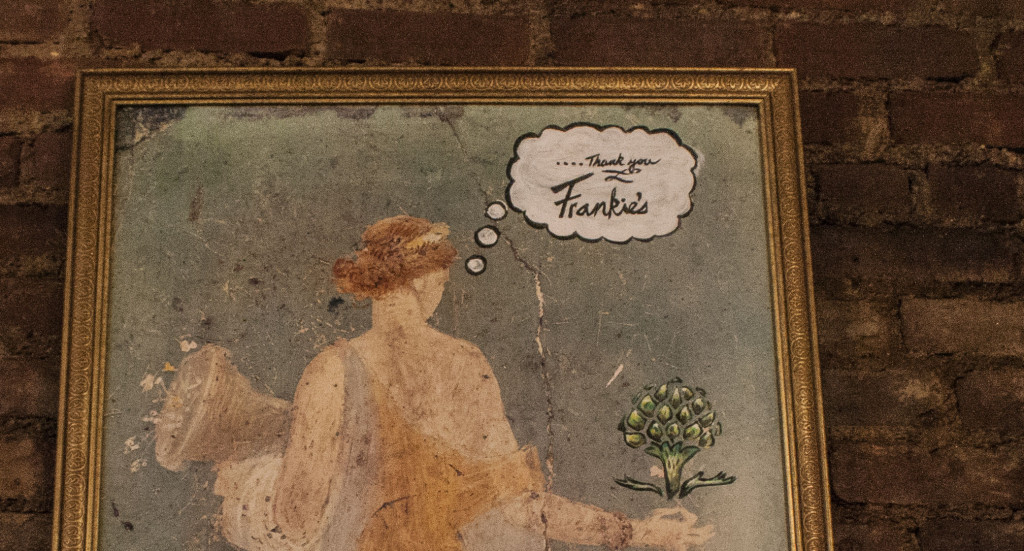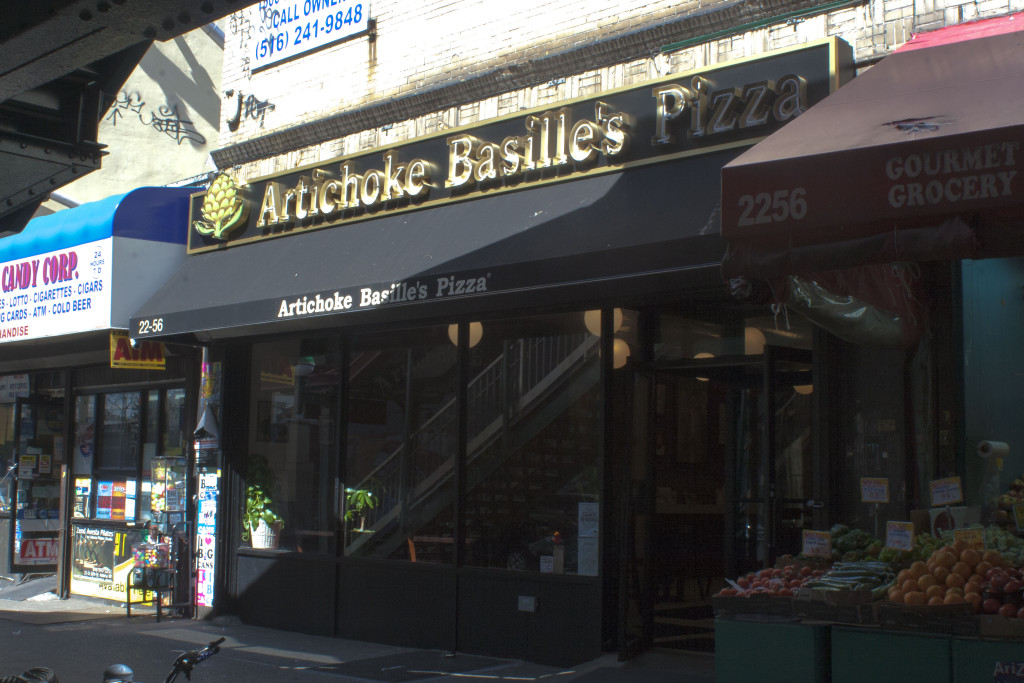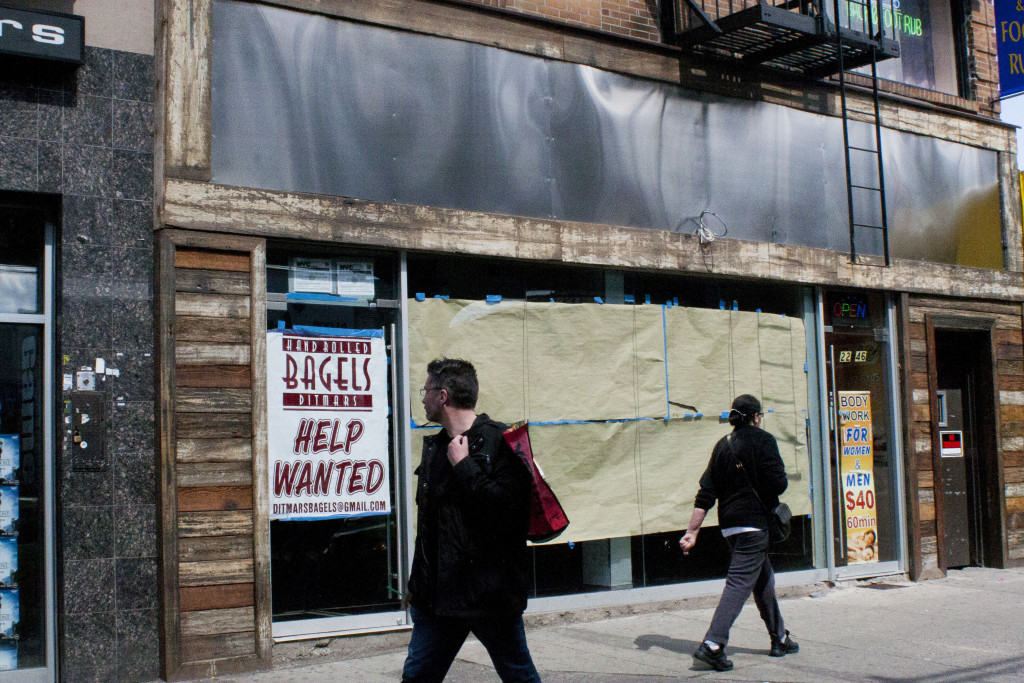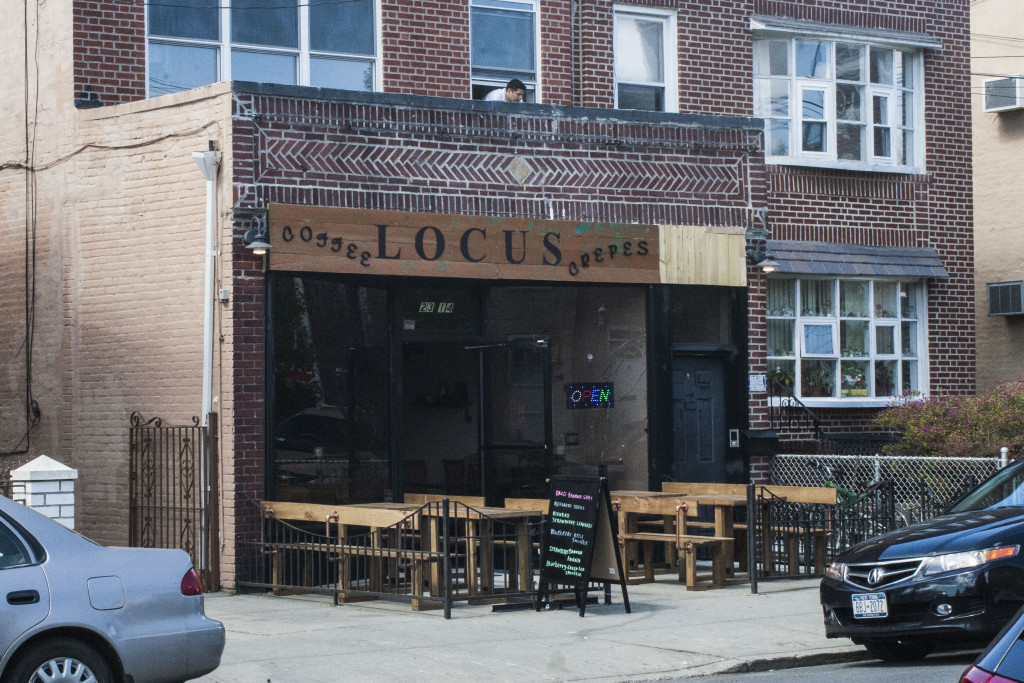Issues: Whose street is it?

An old painting from Frankie’s now hangs in the new Artichoke Basille, modified with a speech bubble. Photograph: Alistair Gardiner.
For the past half a century, hungry locals have been able to get a slice of pizza just under the Ditmars Boulevard subway stop in Astoria, Queens. Since March, though, the slices have cost up to twice as much, $5 instead of $2.50, and they come from Manhattan’s Artichoke Basille Pizza, which replaced the 50-year-old Astoria staple, Frankie’s Pizza.
The pace at which new restaurants are opening is speeding up in Astoria, which along with Long Island City are the Queens neighborhoods that are currently changing the most. This is due to their proximity to Manhattan and the fact that both commercial and residential rents are still lower than in Manhattan and Brooklyn. But rent in Astoria has been increasing yearly for more than a decade. The most recent Modern Spaces Housing Report from the end of 2014 showed that rents had increased 6.25 percent from the previous year. Commercial rents in the area were between $3,000 and $4,000, but in the past 10 years they’ve more than doubled to between $8,000 and $10,000.
The increase in rent has led some businesses to give up on the area as new businesses move in. But James Lettera, the manager of Astoria’s Artichoke Basille Pizza, says that Astoria is an area full of great food and that’s not changing. In fact, that’s one of the reasons why Artichoke Basille picked Astoria.
“Frankie’s was a good opportunity — it’s a great pizza spot,” he says, “and an excellent location right next to the subway station. It’s a great neighborhood and it’s a great food neighborhood too.” The ghost of Frankie’s is still visible on the wall of the new Artichoke Pizza location in the form of an enormous painting that used to hang in the old restaurant. It has now been modified with a speech bubble that says “Thank you… Frankie’s.”
Lettera says that the neighborhood has embraced the new pizza, which is thick-crust and rich, full of more ingredients than your typical slice. “We get the city employees. We get young professionals. We have a different variety of pizza, but we think people will appreciate different ingredients. We’ve had many of Frankie’s customers. They’ve responded well, they love our pizza,” he says. “$4.50 might be a little more than they’re used to paying, but the slices are bigger and they’re more filling. You know, it’s a whole meal.”
In 2010 the Times dubbed Queens “the most diverse place on earth” and the U.S. census bureau found that from 2000 to 2010, the borough’s white population decreased by approximately 13%. But Astoria’s changing in the opposite direction: the white population there has steadily increased to well over 70% over the same period. These new residents are mainly young, relatively wealthy professionals who commute to Manhattan.
This clientele is the driving force behind the changes taking place in Astoria. Paul Halvatzis of Amorelli Realty has lived and worked in Astoria for the past 35 years. “Astoria is re-morphing into a high-end area, with high-end renters moving in,” he says, “and it’s bringing in a whole new clientele into the area.” Halvatzis says that much of this new younger population work in industries like “media, marketing, banking” and are “people who don’t mind spending $12 on one drink.”
But Lettera says that the Artichoke owners are no different to Astoria’s other restaurant-owners. “We did not want to come in there as a big corporate name,” he says, “They want to say it’s gentrification. We just wanted to come in as another pizza spot. They could have put in a CVS, but we took Frankie’s old spot and we brought our own pizza in. We’re a New York brand, you know.” The new Artichoke Pizza on 31st street is the company’s sixth restaurant. Most of Artichoke Basille’s Pizza locations are in affluent areas (Greenwich Village, Chelsea, East Village), but Lettera insists that this doesn’t reflect what the company is all about.
Paul Halvatzis, however, says that the neighborhood is changing considerably. “The thing is, the area used to be little ‘mom n pop’ shops,” he says, “but these guys can no longer afford to pay their rent.” Halvatzis points out a line of businesses just across the road from his office on 30th Avenue, which have all changed hands over the past decade. A Greek place called Piatsa Souvlaki, where a burger is $9.50, replaced Frank’s Bakery, which closed in May 2014. Frank owns the building and now rents it to the owners of Piatsa Souvlaki.
“I guess he felt, after 50 years in business, he could now make more by renting out the building than through selling rolls and croissants,” says Halvatzis.
One of the next stores on the block is a Japanese sushi place called Pink Nori, which used to be an independent fruit and vegetable shop. “The veg store could probably afford to pay $3,000,” says Halvatzis, “That sushi shop is paying $9,000.”
Halvatzis sees these changes as a boost for Astoria, enhancing the area both culturally and economically. “It’s just getting better and better,” he says.
Valerie Smosna, a student who also works at Queensboro community college, is a 23-year-old resident who’s lived in the area since she was six. She doesn’t share Halvatzis’ enthusiasm. “Really, I noticed the changes in the last five years a lot,” she says. “There’s a lot of very expensive restaurants.” For Smosna, the significance is in the impact on Astoria’s character, which she says may be slowly disappearing. “Artichoke has a very lower-Manhattan identity,” she says, “It’s not very Astoria, so I wasn’t happy about that.”
That’s not an isolated example. “I feel like there’s some bars up on Broadway and 30th Avenue, that you walk in and they’re like fancy Brooklyn bars,” she says. Though Smosna is happy with some of the changes taking place in Astoria (“It is nice to have new bars to go out to,” she says), she does have concerns about in the number of empty store-fronts that are popping up in the neighborhood. She mentions a corner fruit store called Hot Tomato, which used to be on Ditmars Boulevard, and which closed last year. “The property has been vacant every since,” she says.
Restaurant economics also drive the change in the landscape. It’s easier to own multiple restaurants, because revenues from one location can support another that has a bad month. Marie Torniali, the executive director of the Central Astoria Local Development Coalition, feels that this is a big part of why more chain restaurants are opening in Astoria.
New employee-rights legislation also makes it harder for the type of small business that used to define Astoria. “The sick leave law will affect them a lot more, as well as the living wage laws,” says, Torniali, referring to a new requirement that any business with more than five employees must allow 40 hours of paid sick leave for each one. “If you have five employees and you’re giving them each a week off, it’s going to affect the small businesses more.”
She also says that minimum wage hikes, set to go into effect in December, will affect many of Astoria’s independent businesses. “I’ve heard quite a few say that maybe they’re going to have to let someone go,” she says. “The larger companies are just better equipped to deal with this.”
Rosary Immordino, 66, lived in Astoria for over 20 years, before moving to Jackson Heights with her husband. “You’d have to be crazy not to notice what it’s become,” she says. “It’s hip now.” For Immordino the changes have already happened. “It’s not a neighborhood anymore in the same way that it was,” she says.
Like others, Immordino has lost her own favorite dining spot in the area. “There was a Czech restaurant. It was a cheap food bar type place. That’s closed now,” she says. Immordino is referring Zlata Praha on 31st street, which closed in 2013. “Every time I go, there’s a little less of the Astoria I know,” she says.
Not all of the new cafes and restaurants are chains or designed to attract the new wealthy residents — there are a number of independent family-oriented places opening that don’t quite fit the usual gentrification narrative. Dina Kowalczyk has been living in Astoria for 10 years. In January, she and her daughter opened Locus Café, on Ditmars Boulevard.
“I picked Astoria because I live around here,” she says. “It is my neighborhood.” Kowalczyk says that though the area has changed a lot, becoming more populated, that this is “good for everybody!” For her, the increased number of potential customers seems to offset any worry about rising rent. “I’m not concerned,” she says, “It’s good that we get more people. Younger, older, everything! All kinds.”
Locus Café gets most of its customers during the day for coffee and savory or sweet crepes. While Kowalczyk understands the benefits of trying to expand a restaurant into a franchise, that this isn’t her intention. “It’s a small business here. I’m not interested in a franchise,” she says, “I’m happy with this right now.”
“I’m happy that I know my customers, and I’m happy that they’re happy with my product,” she says, “I love my customers. They are my neighbors.”
Tags: #Artichoke, #Basille, #Pizza, Astoria, gentrification, Queens, restaurants



Your Comments